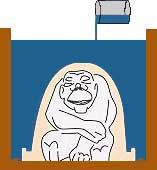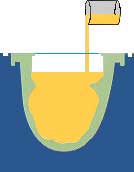Mold Making Guide - One Part Skin Molding
One Part Skin Molding
Producing the Backing Case
The backing case (blue colored in figure) can be made from plaster or epoxy resin or polyurethane, by casting or by polyester lamination. It is often advisable to strengthen the backing case using struts made from cardboard or plywood coated in glass fibre + polyester.

The model must be surface treated. Cover the model in a very fine layer of vaseline spread it under stream of hot air.
Position the model on the base, attach by screwing, seal the joint between the model and the base with plastiline avoiding any air inclusions. The model is then covered in aluminium foil, with a layer of plastiline of constant thickness.
A mold release agent is applied to all surfaces of the dismantable frame, then the backing case can made from the materials listed above.
Position the model on the base, attach by screwing, seal the joint between the model and the base with plastiline avoiding any air inclusions. The model is then covered in aluminium foil, with a layer of plastiline of constant thickness.
A mold release agent is applied to all surfaces of the dismantable frame, then the backing case can made from the materials listed above.

Producing the Membrane
The frame is dismantled, the mold is opened. The plastiline is removed together with the protective film, the plastiline is weighed to know how much RTV is to be used.
The pouring and venting holes are made. To pour the RTV drill a hole vertically from the lowest part of the model.
Cover the whole internal surface of the backing case with vaseline to avoid any suction, spread the vaseline by a hair dryer.
The frame is dismantled, the mold is opened. The plastiline is removed together with the protective film, the plastiline is weighed to know how much RTV is to be used.
The pouring and venting holes are made. To pour the RTV drill a hole vertically from the lowest part of the model.
Cover the whole internal surface of the backing case with vaseline to avoid any suction, spread the vaseline by a hair dryer.

Position the backing case on the model again, fix them together and set up a funnel on the pouring tube. Mix the RTV components and degas then pour throught the funnel and wait to cure.
One Part Block Molding
Two Part Block Molding
One Part Skin Molding
Two Part Skin Molding
One Side Impression Molding (Brush Molding)
Two Part Impression Molding (Brush Molding)
